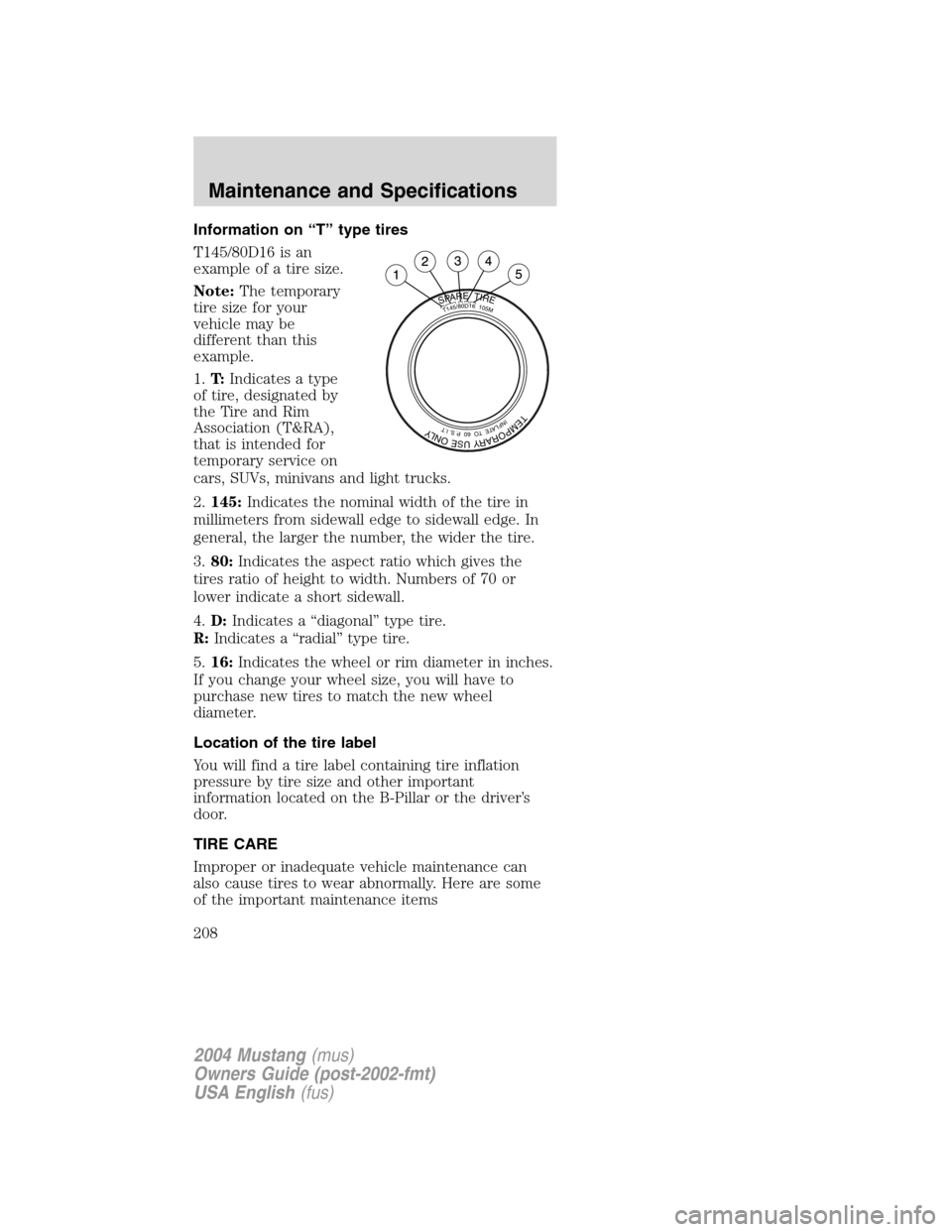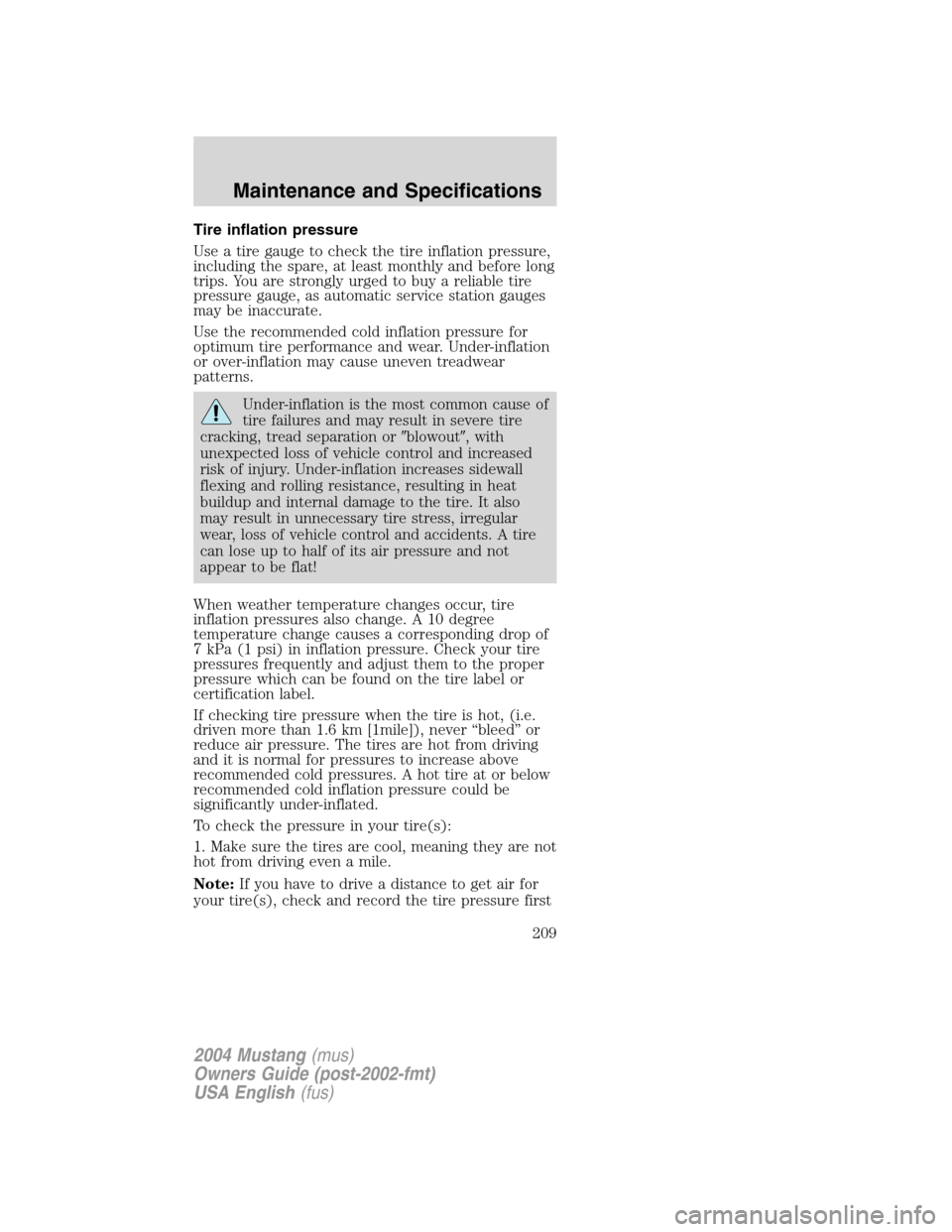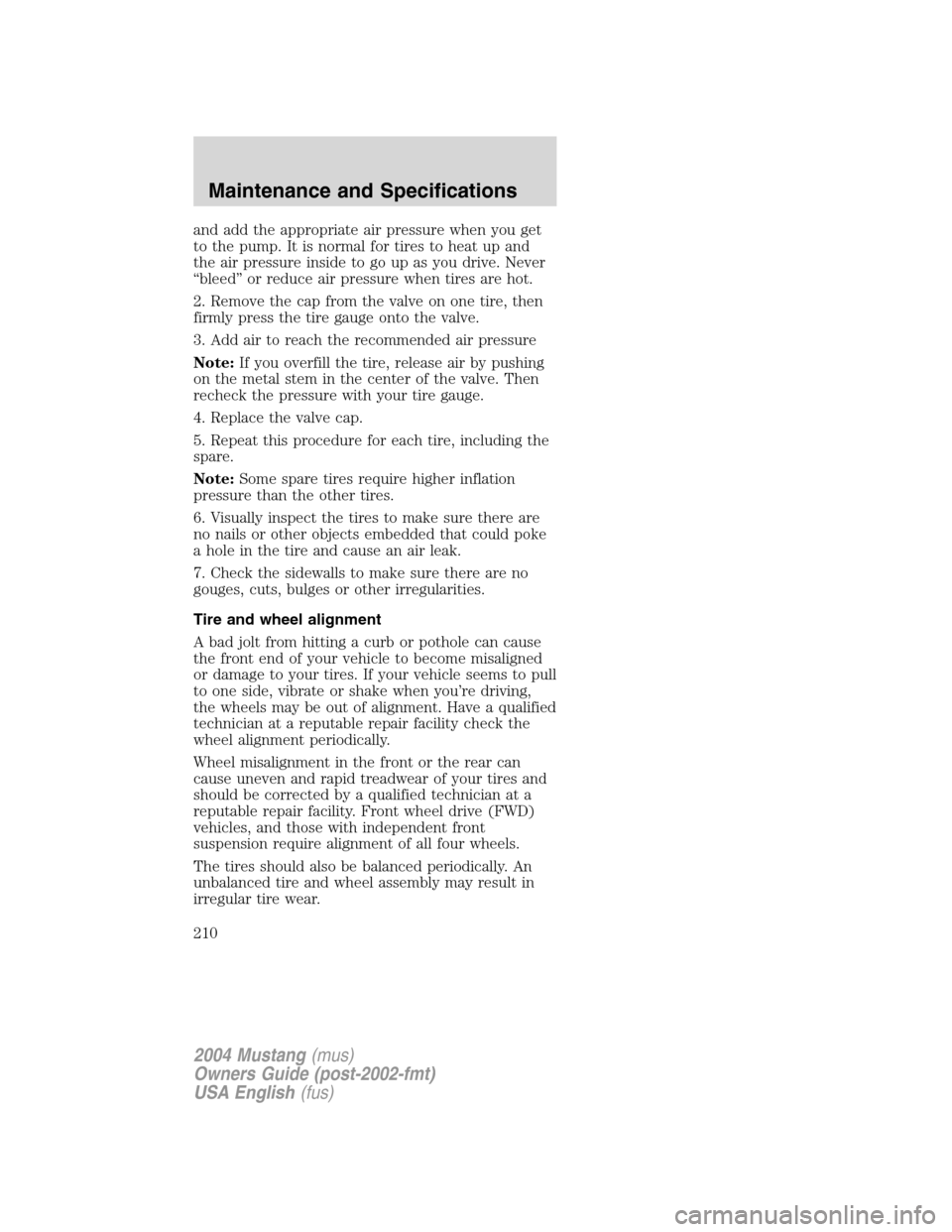Page 207 of 240
Additional information contained on the tire
sidewall for“LT”type tires
“LT”type tires have
some additional
information than those
of“P”type tires; these
differences are
described below:
1.LT:Indicates a tire,
designated by the Tire
and Rim Association
(T&RA), that is
intended for service on
light trucks.
2.Load Range/Load Inflation Limits:Indicates
the tires load-carrying capabilities and its inflation
limits.
3.Maximum Load Dual kg (lbs.) at kPa (psi)
cold:Indicates the maximum load and tire pressure
when the tire is used as a dual; a dual is defined as
when four tires are put on the rear axle (a total of
six or more tires on the vehicle).
4.Maximum Load Single kg (lbs.) at kPa (psi)
cold:Indicates the maximum load and tire pressure
when the tire is used as a single; a single is defined
as when two tires (total) are put on the rear axle.
2004 Mustang(mus)
Owners Guide (post-2002-fmt)
USA English(fus)
Maintenance and Specifications
207
Page 208 of 240

Information on“T”type tires
T145/80D16 is an
example of a tire size.
Note:The temporary
tire size for your
vehicle may be
different than this
example.
1.T:Indicates a type
of tire, designated by
the Tire and Rim
Association (T&RA),
that is intended for
temporary service on
cars, SUVs, minivans and light trucks.
2.145:Indicates the nominal width of the tire in
millimeters from sidewall edge to sidewall edge. In
general, the larger the number, the wider the tire.
3.80:Indicates the aspect ratio which gives the
tires ratio of height to width. Numbers of 70 or
lower indicate a short sidewall.
4.D:Indicates a“diagonal”type tire.
R:Indicates a“radial”type tire.
5.16:Indicates the wheel or rim diameter in inches.
If you change your wheel size, you will have to
purchase new tires to match the new wheel
diameter.
Location of the tire label
You will find a tire label containing tire inflation
pressure by tire size and other important
information located on the B-Pillar or the driver’s
door.
TIRE CARE
Improper or inadequate vehicle maintenance can
also cause tires to wear abnormally. Here are some
of the important maintenance items
SPARETIRE
TEMPORARYUSEONLYINFLATETO60P.S.I.T
T145/80D16105M
2004 Mustang(mus)
Owners Guide (post-2002-fmt)
USA English(fus)
Maintenance and Specifications
208
Page 209 of 240

Tire inflation pressure
Use a tire gauge to check the tire inflation pressure,
including the spare, at least monthly and before long
trips. You are strongly urged to buy a reliable tire
pressure gauge, as automatic service station gauges
may be inaccurate.
Use the recommended cold inflation pressure for
optimum tire performance and wear. Under-inflation
or over-inflation may cause uneven treadwear
patterns.
Under-inflation is the most common cause of
tire failures and may result in severe tire
cracking, tread separation or�blowout�, with
unexpected loss of vehicle control and increased
risk of injury. Under-inflation increases sidewall
flexing and rolling resistance, resulting in heat
buildup and internal damage to the tire. It also
may result in unnecessary tire stress, irregular
wear, loss of vehicle control and accidents. A tire
can lose up to half of its air pressure and not
appear to be flat!
When weather temperature changes occur, tire
inflation pressures also change. A 10 degree
temperature change causes a corresponding drop of
7 kPa (1 psi) in inflation pressure. Check your tire
pressures frequently and adjust them to the proper
pressure which can be found on the tire label or
certification label.
If checking tire pressure when the tire is hot, (i.e.
driven more than 1.6 km [1mile]), never“bleed”or
reduce air pressure. The tires are hot from driving
and it is normal for pressures to increase above
recommended cold pressures. A hot tire at or below
recommended cold inflation pressure could be
significantly under-inflated.
To check the pressure in your tire(s):
1. Make sure the tires are cool, meaning they are not
hot from driving even a mile.
Note:If you have to drive a distance to get air for
your tire(s), check and record the tire pressure first
2004 Mustang(mus)
Owners Guide (post-2002-fmt)
USA English(fus)
Maintenance and Specifications
209
Page 210 of 240

and add the appropriate air pressure when you get
to the pump. It is normal for tires to heat up and
the air pressure inside to go up as you drive. Never
“bleed”or reduce air pressure when tires are hot.
2. Remove the cap from the valve on one tire, then
firmly press the tire gauge onto the valve.
3. Add air to reach the recommended air pressure
Note:If you overfill the tire, release air by pushing
on the metal stem in the center of the valve. Then
recheck the pressure with your tire gauge.
4. Replace the valve cap.
5. Repeat this procedure for each tire, including the
spare.
Note:Some spare tires require higher inflation
pressure than the other tires.
6. Visually inspect the tires to make sure there are
no nails or other objects embedded that could poke
a hole in the tire and cause an air leak.
7. Check the sidewalls to make sure there are no
gouges, cuts, bulges or other irregularities.
Tire and wheel alignment
A bad jolt from hitting a curb or pothole can cause
the front end of your vehicle to become misaligned
or damage to your tires. If your vehicle seems to pull
to one side, vibrate or shake when you’re driving,
the wheels may be out of alignment. Have a qualified
technician at a reputable repair facility check the
wheel alignment periodically.
Wheel misalignment in the front or the rear can
cause uneven and rapid treadwear of your tires and
should be corrected by a qualified technician at a
reputable repair facility. Front wheel drive (FWD)
vehicles, and those with independent front
suspension require alignment of all four wheels.
The tires should also be balanced periodically. An
unbalanced tire and wheel assembly may result in
irregular tire wear.
2004 Mustang(mus)
Owners Guide (post-2002-fmt)
USA English(fus)
Maintenance and Specifications
210